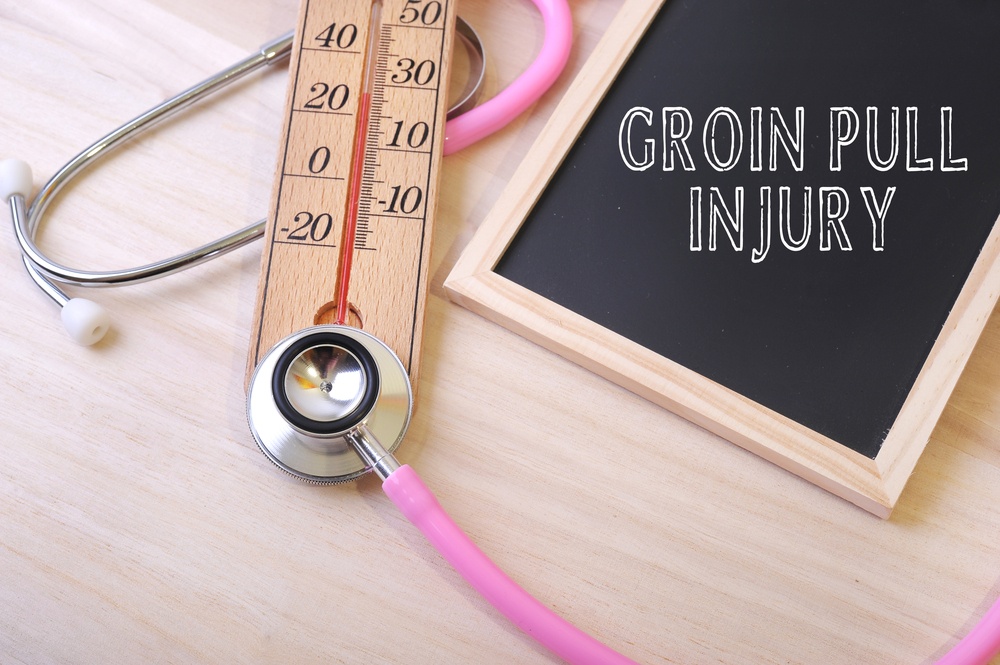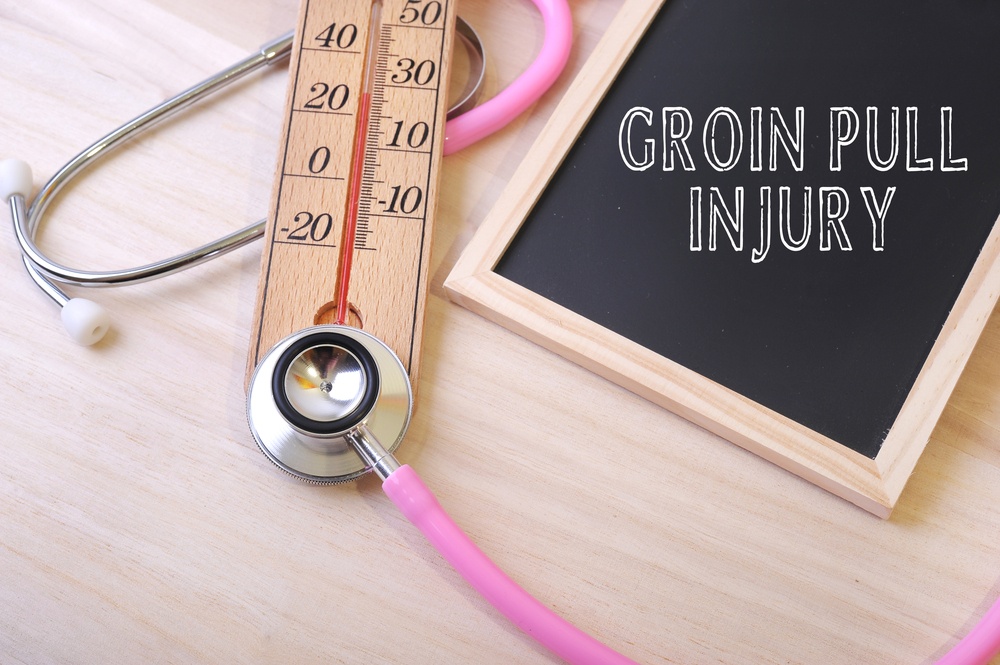What is a Pulled Groin Muscle? (Causes, Symptoms, Treatment, and Recovery)
October 24th, 2018 | 4 min. read


A pulled groin, also called a groin strain, can occur when you put too much stress on your groin and thigh muscles. If you tense these muscles too suddenly or too forcefully, they can become torn or overstretched.
Groin pulls are common in individuals who participate in sports requiring a lot of jumping and running, particularly when suddenly changing direction or jumping is involved. Pulled groins frequently appear in individuals who play football and soccer. They also account for around 10 percent of all professional hockey and soccer player injuries, reports the peer-reviewed medical journal Sports Health.
Common Causes of a Pulled Groin Muscle
A pulled groin muscle is most common among both recreational and professional athletes. A common cause of a groin pull is when an athlete strains their adductor muscle while kicking — typically in their dominant leg.
Other things can cause this injury such as turning quickly while:
-
Skating
-
Running
-
Jumping
A groin strain is a high possibility when you perform movements requiring your muscle to both contract and lengthen simultaneously because it stresses your muscle, leading to it tearing or overstretching.
While the most common cause of a pulled groin is sports, it can also occur from:
-
Lifting heavy objects
-
Overusing a muscle leading to a long-term strain
-
Falling
-
Certain exercises like resistance training
Symptoms of a Pulled Groin Muscle
The primary pulled groin symptoms are tenderness and pain in the area. Other symptoms might include:
-
Pain when you raise your knee
-
Swelling or bruising of your inner thigh
-
Muscles feel tight or weak
-
Pain when you open or close your legs
-
Difficulty moving the leg or limping
-
Your inner thigh or groin will feel warmer than normal
The pain you experience can go from being a dull ache to a sharp pain. It will often become worse when moving the leg or walking. You may also experience spasms in your inner thigh muscles.
Symptoms vary depending on the grade of your groin strain and are:
- Grade 1: You might not notice mild pain until you've finished exercising, followed by tenderness and tightness. You probably won't have much difficulty walking with this grade of strain and activity will typically not be limited.
- Grade 2: You may experience tightness and moderate pain in your groin, along with minor bruising and swelling. Your leg may feel weak with a grade 2 strain, and you will likely experience increased pain when stretching the muscle. Your walking could be affected and it may be difficult to run.
- Grade 3: With this grade strain, you're likely experiencing severe pain with considerable bruising and swelling. You likely can't squeeze your legs together and may be able to feel a gap in your muscle if there's a complete tear. At this point, walking will be difficult for you.
A groin strain or groin pull is typically a clear diagnosis. Many athletes will likely know they have a strain before they see a doctor. But, there are other conditions that can cause symptoms similar to a groin pull. For instance, sports hernias have been diagnosed in individuals also with a chronic groin strain diagnosis. The sports hernia symptoms are almost the same as those of a groin pull or strain.
Other conditions that could mimic groin strain symptoms include:
-
Hip-joint problems, including labral tears, arthritis and other conditions
-
Osteitis pubis or pubic bone inflammation
-
Low back problems like pinched nerves
Treatment for a Pulled Groin Muscle
Our orthopedic doctor will perform certain tests in order to officially diagnosis a groin strain or groin pull such as:
-
X-ray
-
Physical exam
-
MRI (helps rule out other issues)
Once they provide you with your strain diagnosis, they'll come up with a pulled groin treatment plan for you, often starting with treatments you can do at home like:
-
Ice therapy: You'll apply ice to the inner area of your thigh to help relieve swelling and pain due to the strain. Your doctor will like suggest you apply the ice every three to four hours for 30 minutes each for two to three days.
-
Heat treatment: Muscle spasm or muscle tear can cause groin pain that lasts for a prolonged time period. Spasm could be continuous or intermittent. Pain or spasm could last for several hours a day. Heat treatment helps provide instant pain relief and in many situations, relieves muscle spasm.
-
Nonsteroidal Anti-Inflammatory Drugs (NSAIDs): These include ibuprofen (Motrin, Advil) and aspirin (Ecotrin, Bufferin) that help reduce inflammation and pain and improve your ability to move around. But, aspirin shouldn't be given to children.
-
Rest: Rest after a groin pull helps with the recovery.
Call us here at Coastal Orthopedics if you've sustained a significant muscle injury that home care remedies aren't providing relief within 24 hours.
Seek medical attention at your local emergency department if you:
-
Can't walk
-
Hear a "popping" noise with the injury
-
Are experiencing significant pain or swelling
-
Have open cuts
-
Have a fever
Depending on how severe your strain is, you might require additional treatments to help with the healing such as:
-
Massage therapy
-
Physical therapy
-
Electrotherapy
-
Stretching and heat
Surgery
You might require surgery if you have a grade 3 strain to repair torn fibers, particularly if a tendon is involved.
Surgical treatment will depend on what caused your groin pull. Ligamental tear or muscle tear can be treated with simply surgery like suturing muscles or tendon.
Trigger Point Injection
The doctor can use trigger point injection treatment for pain caused by:
-
Ligamentous injury
-
Muscle contraction
-
Scarring of soft tissue
-
Ligament inflammation
Soft scarring tissue, including scar tissue, occurs after healing of tendon, muscle and ligament injury or tear. Trigger point injection includes injection of cortisone and local anesthetics within the painful scar tissue or next to painful soft tissue. This technique requires a cautious approach to prevent injecting the medications within nerve fibers or blood vessels.
If you've suffered a previous groin strain or pull already, regular thigh muscle strengthening exercises can be beneficial, particularly to prevent future groin strain or pull.
Pulled Groin Recovery Time
Pulled groin recovery time depends on the degree of your injury. Generally, you can use your level of pain to gauge your recovery time.
While your adductor muscle is recovering, you should avoid pain-involving activities. You can gradually resume activities which will prevent you from experiencing a recurrent groin pull injury and allow your muscle to fully heal.
The length of time needed for recovery will also depend on what your fitness level was before the injury. Each person is different, therefore, there's no definitive time frame.
But, as a general guideline, you can expect to rest for a few weeks before you can get back to your full activities.
Depending on what grade your strain is, here's the estimated times of recovery:
-
Two to three weeks for a grade 1 injury
-
Two to three months for a grade 2 injury
-
Four months or more for a grade 3 injury
The outcome of a pulled groin and associated pain will depend on the cause. The treatment outcome for groin pain due to muscle spasm is great. The relief from the pain lasts for a prolonged period, however, spasm could come back depending on the trigger factors.
Seek Evaluation and Treatment for a Pulled Groin Muscle at Coastal Orthopedics
Here at Coastal Orthopedics in Corpus Christi, our orthopedic medical treatment can get your back to your active lifestyle and everyday routine quickly. If you believe you have the symptoms of a pulled groin muscle, contact us today at by calling 361-529-92455 or completing our online form. We look forward to helping you get back to all the activities you enjoy.
Dr. Williams has been practicing orthopedic surgery in Corpus Christi since 1998. After graduating from Texas Tech hereceived his medical degree from the University of Texas at San Antonio. At the prestigious Campbell Clinic located at the University of Tennessee, Dr. Williams completed not only an Orthopedic Surgery Residency, but an additional year of Fellowship Training in Spine Surgery. Dr. Williams is dedicated to creating an excellent patient experience in the office or in the surgery suite.
Topics:


